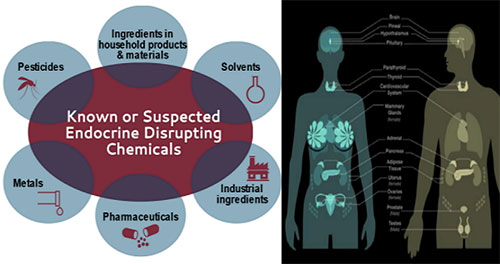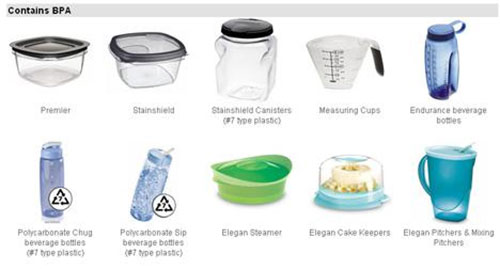How to avoid hormone disrupting chemicals
Endocrine disrupting chemicals (EDCs) are similar in structure to natural hormones such as the female sex hormone estrogen, the male sex hormone androgen, and thyroid hormones.

EDCs interfere with development, reproduction, neurological functioning, metabolism, satiety and your immune system function, and much more, and for many of these chemicals, there may be no safe level of exposure.
12 of the worst and most widely used EDCs are: BPA, dioxin, atrazine, phthalates, perchlorate, fire retardants, lead, mercury, arsenic, PFCs, organophosphate pesticides and glycol ethers.
10 common routes of exposure include personal care products, drinking water, canned and packaged foods, conventionally grown produce and CAFO meat, poultry and dairy products, high-mercury fish, plastic and nonstick kitchenware, cleaning products, household dust, office products and cash register receipts.
Suggestions for how to avoid or limit exposure are included
Endocrine disrupting chemicals (EDCs) are similar in structure to natural hormones such as the female sex hormone estrogen, the male sex hormone androgen and thyroid hormones, which allow them to interfere with development, reproduction, neurological functioning, metabolism, satiety and your immune system function, and much more.
For example, they may block certain hormonal signals, alter your hormone levels, or change the way your natural hormones travel through your body. As noted in a World Health Organization (WHO) report published in 2012, the effects of EDCs on your hormonal systems “can lead to obesity, infertility or reduced fertility, learning and memory difficulties, Type 2 diabetes or cardiovascular disease, as well as a variety of other diseases.”
What’s more, since hormones operate at parts per million and parts per billion concentrations, the Endocrine Society warns there may be no safe level of exposure for many EDCs, and that the health effects are so great everyone needs to take proactive steps to avoid them – especially those seeking to get pregnant, pregnant women and young children.
Strong Evidence Supports Warnings to Avoid EDCs
Commenting on the publication of its first scientific statement on EDCs in 2009, the Endocrine Society noted that:
“The evidence for adverse reproductive outcomes (infertility, cancers, malformations) from exposure to endocrine disrupting chemicals is strong, and there is mounting evidence for effects on other endocrine systems, including thyroid, neuroendocrine, obesity and metabolism, and insulin and glucose homeostasis …
Effects of endocrine disrupting chemicals may be transmitted to further generations through germline epigenetic modifications or from continued exposure of offspring to the environmental insult.”
At the end of 2015, the Endocrine Society issued its second scientific statement on EDCs, noting that in the years gone by, “a substantially larger body of literature has solidified our understanding of plausible mechanisms underlying EDC actions and how exposures in animals and humans – especially during development — may lay the foundation for disease later in life.”
In short, the evidence is only getting stronger, showing that exposure to EDCs in the environment can have significant health effects for both children and adults, and that these effects can be further transmitted to future generations. The report also points out that causal links between exposure and manifestation of disease have been substantiated, as have low-dose effects. The strongest evidence, the report found, is for the link between EDC exposure and:
– Obesity
– Diabetes
– Female reproduction
– Male reproduction
– Hormone-sensitive cancers in women
– Prostate problems in men
– Thyroid problems
– Neurodevelopment and neuroendocrine system effects
Another report published in 2015 estimated the financial burden of EDC exposure in the European Union, producing a median cost of 157 billion euros or $209 billion annually for health care expenses related to IQ loss, intellectual disability, autism, attention-deficit hyperactivity disorder, obesity, diabetes, cryptorchidism, infertility and mortality associated with reduced testosterone levels.
The 12 Worst Hormone Disrupting Chemicals
While the list of known EDCs is extensive, and the list of possible EDCs even more so, a dozen of the worst and most widely used ones, identified by the Environmental Working Group in 2013, include:

– Bisphenol-A (BPA)
– Dioxin
– Atrazine
– Phthalates
– Perchlorate
– Fire retardants (polybrominated diethyl ethers or PBDEs)
– Lead
– Mercury
– Arsenic
– Perfluorinated chemicals (PFCs)
– Organophosphate pesticides
– Glycol ethers
10 Common Routes of EDC Exposure and How to Avoid Them
According to the Hormone Health Network, which is a part of the Endocrine Society, there are an estimated 1,000 man-made chemicals on the market with endocrine-disrupting properties. Following are 10 common routes of exposure, and some commonsense tips for how to avoid them:
Personal care products – Shampoos, conditioners, moisturizers, cosmetics and other personal care products often contain EDCs, including (but certainly not limited to) phthalates, associated with testicular cancer, genital deformations, low sperm counts and infertility in a number of species, including polar bears, deer, whales and otters, just to name a few. Another EDC found in this category is triclosan, found in many products boasting antibacterial properties.
Avoid by: Switching to certified organic and/or homemade personal care products. You can also try to cut down on the number of personal care products you use every day. Avoid antibacterial soaps, wipes and sanitizer gels. All you need to degerm your hands is warm water and a mild soap using proper handwashing technique.
Drinking water – Your drinking water may be contaminated with atrazine, glyphosate, arsenic, perchlorate and/or fire retardant chemicals, all of which may disrupt your endocrine system.
Avoid by: Filtering your water, both at your tap and your shower/bath, using a high-quality water filtration system.
Canned goods and nonstick food packaging – These are common sources of BPA and similar EDCs such as BPS, or other toxic substitutes such as PVC. According to a 2017 investigation by the Center for Environmental Health, 38 percent of canned foods still contain BPA.
Avoid by: Buying products that come in glass bottles and jars rather than plastic or cans.
Conventionally grown produce and CAFO meat, poultry and dairy products – Pesticides, herbicides and industrial runoff may coat your conventionally grown fruits and vegetables in EDCs. Animals raised on concentrated animal feeding operations (CAFOs) also typically contain antibiotics, hormones and other industrial chemicals that may disrupt your endocrine system.
Avoid by: Buying and eating organic produce and grass fed animal products to minimize exposure to endocrine-disrupting pesticides, herbicides and veterinary drugs.
Also, wash all produce before eating, even if it’s organic. Organic foods have a 30 percent lower risk of pesticide contamination, but it’s not entirely possible to guarantee organic produce is pesticide-free, as it is sometimes located in adjacent fields to farms where pesticides are used.
Research suggests pesticide residues on apples are most effectively removed using a 1% baking soda and water solution. The researchers recommend using 1 teaspoon of baking soda for every 2 cups of water and gently scrubbing your produce to remove surface pesticides.
High-mercury fish – Fish contaminated with high levels of mercury and other heavy metals are problematic because such metals also disrupt your hormonal balance. Shark, swordfish, king mackerel, marlin, sea bass and tuna are among the worst offenders. Both the U.S. Environmental Protection Agency and U.S. Food and Drug Administration have placed canned tuna on its “choices to avoid” list for pregnant women and small children due to its high mercury levels.

Farmed fish (the ‘CAFOS of the sea’) also tend to be higher in contaminants and are better off avoided. Farmed salmon is among the very worst in this regard.
Avoid by: Carefully selecting seafood known to be low in mercury and other contaminants. Some of your safest and healthiest options include smaller fish such as sardines, anchovies, mackerel and herring. Wild-caught Alaskan salmon is another good choice.
For more information about mercury in fish, see the Mercury Policy Project’s website, Mercury and Fish: The Facts. They have a helpful guide you can print out for reference. A 2015 article in Investigate West also addressed this issue, and includes a guide to how many meals per week you can safely eat based on any given seafood’s contamination level.
Kitchenware – Plastic containers and bottles may contain BPA or other endocrine-disrupting plastic chemicals that can leach into your food, especially if the plastic is heated. Poly- and perfluoroalkyl substances (PFAS) used to create nonstick, stain-resistant and water-repellant surfaces are also toxic and highly persistent, both in your body and in the environment.
When heated, nonstick cookware releases perfluorooctanoic acid (PFOA), which has been linked to thyroid disease, infertility and developmental and reproductive problems.
Avoid by: Using glass containers and ceramic and enameled cast iron cookware, both of which are durable, easy to clean (even the toughest cooked-on foods can be wiped away after soaking it in warm water), and completely inert, which means they won’t release any harmful chemicals into your home. If you do use plastic containers, do not heat food in them in the microwave.
Cleaning products – Commercial solutions used to clean your floors, toilets, oven, windows and more typically contain industrial chemicals that may throw your hormones out of whack. Many EDCs also lurk in fragrances, and this applies to personal care products as well.
Avoid by: Creating your own cleaning products using different combinations of vinegar, baking soda, essential oils and even coconut oil. To get you started, see “Keep a Clean House With Nontoxic Cleaners.” Avoid scented products, including air fresheners, scented trash bags and so on.
Household dust – Fire retardant chemicals are often found lurking in household dust as they shed from treated furniture such as couches, mattresses and carpet padding.
Avoid by: Buying “green” nontoxic furniture, mattresses and building materials whenever possible and using a HEPA filter for your vacuum. When mopping and dusting, use a wet mop or rag to avoid scattering the dust.
Office products – Ink cartridges, toners and other solvents common in office environments are another common source of EDCs.
Avoid by: Handling such products with care and minimize your exposure as much as possible.
Cash register receipts – Thermal paper typically contains BPA, and research shows handling this type of paper is enough to increase the BPA level in your body.
Holding the paper for just five seconds was enough to transfer BPA onto a person’s skin, and the amount of BPA transferred increased by about 10 times if the fingers were wet or greasy (such as if you’ve just applied lotion or eaten greasy food). Finally, because receipts are often stored next to paper currency in people’s wallets, paper currency may also be contaminated with BPA.
In a study published in Environmental Science and Technology, researchers analyzed paper currencies from 21 countries for the presence of BPA, and the chemical was detected in every sample.
Avoid by: Using paperless receipts via email or text message. Avoid carrying receipts in your wallet or purse, as it appears the chemical can transfer onto other surfaces. It would also be wise to wash your hands after handling receipts and currency, and avoid handling them particularly if you’ve just put on lotion or have any other greasy substance on your hands, as this may increase your exposure.
If you’re a cashier or bank teller who handles such papers often, you may want to wear gloves, especially if you’re pregnant or of child-bearing age.
yogaesoteric
January 26, 2020
